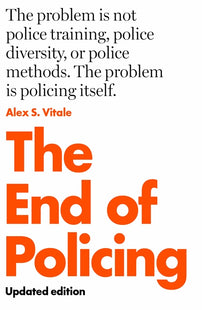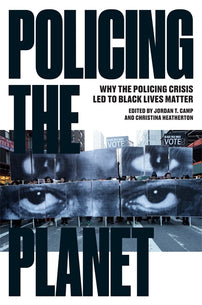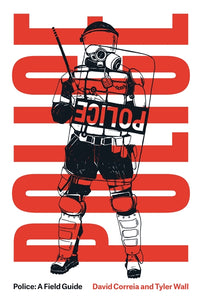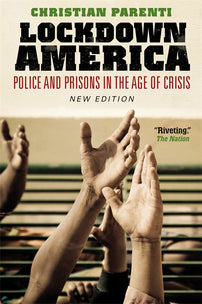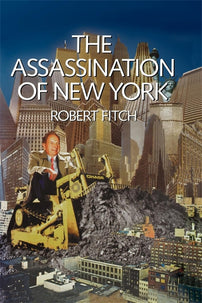What Qualities? Whose Lives?: Policing and Resistance on the New York Subways
On Friday, November 1st, hundreds of people jumped the turnstiles of the New York City subway system in a mass fare evasion following a raucous march through the streets of Brooklyn. The demonstration was called in reaction to an intensification of policing on the subway in the past few months. With further protests scheduled for this Friday in Harlem, Andy Battle looks at the context of the protests in the history of police and state violence in the city, and the re-enclosure of the social in New York over the last forty years.

On Friday, November 1st, hundreds of people jumped the turnstiles of the New York City subway system in a mass fare evasion. “How do you spell ‘racist?’” they chanted. The answer: “N-Y-P-D!”
This act of collective law-breaking, and the raucous march through the streets of Brooklyn that preceded it, was a response to an intensification of policing on the subway, the 840-mile network of tracks that ferries millions of New Yorkers a day across the city’s five boroughs. Public transit is the lifeblood of New York, both an essential component of the machinery of accumulation and a vehicle of everyday freedom. Yet, like all collective goods in a society riven by the conflict between the imperatives of capital and the needs and desires of the rest of us, it is one torn by contradictions. The front-line managers of these contradictions are the police.
[book-strip index="1" style="buy"]In September, the government agency responsible for New York’s subways, the Metropolitan Transportation Authority (MTA), announced it would hire five hundred new cops to address so-called “quality-of-life” issues on the trains. This proposed investment in policing was accompanied by an aggressive new strategy of confrontation towards non-normative bodies and behaviors. The direct results of this approach were seen on October 25, when a group of officers threw a Brooklyn subway station into chaos by drawing weapons on a train car filled with commuters and gang-tackling a terrified nineteen-year-old African American named Adrian Napier, while other officers worked to prevent bystanders from filming the arrest. For New Yorkers with memories of the decades-long litany of police murders in the city, the video of the event was traumatic. The incident came on the heels of four police shootings in one week—three of them fatal—and was followed by a messy brawl inside another Brooklyn station the following day, during which a frenzied officer singled out a teenage onlooker, punching him in the face. One of the cops involved in that melee had made headlines last year when she and several other officers roughed up an infant at a public benefits office. As the weeks drew on, the crackdown continued, with food vendors, especially the Latina women who sell fruit and churros, finding themselves subject to harassment and arrest where they had once been tolerated.
Following Napier’s arrest, a familiar script began to play. Officers claimed they believed the teenager had a gun. Whether they actually believed this, we will never know—experience teaches us that to take New York police at their word is, at best, naïve. In the end, Napier was charged with fare evasion, having jumped the turnstiles in an effort to flee his pursuers. He was, Take Back the Bronx organizer Shellyne Rodriguez affirmed, “the Black Lives Matter victim that got to live.”
“Evasion” is itself a strange word—a judgment masquerading as a description. Contained within it is the assertion that the decision not to pay is a choice. Such assumptions are unjustified. Flat fares, like flat taxes, are regressive, penalizing the poorest, while the series of price hikes since 2009 has outpaced inflation, putting mobility even further out of reach for the city’s most vulnerable residents. In a city where spatial inequalities run rampant, the effects of not being able to leave one’s neighborhood are severe, helping to lock victims into a cycle of poverty.
Jumping the turnstiles, whether as isolated protest or measure of last resort, can kick-start a series of recriminations that haunt arrestees for years. “We’d rather your $2.75 fare than your $100 fine,” reads a condescendingly chirpy new advertising campaign mounted by the MTA. This copy could only have been written by someone with no idea of the nightmares exerted on the lives of the poor by these supposedly minor fines. In response, a group of activists replaced the signs with a more insightful message: “Together, we can make a better world. Public transit is for the people, but not everyone can afford $2.75. So when you see someone in need, swipe it forward.”
While the MTA undoubtedly faces severe financial problems, fare evasion is not a meaningful part of them. No one claims that the five hundred new officers, who will require eighty-one new supervisors, will foil enough turnstile jumpers to cover the staggering cost of hiring them. And yet, while layoffs and service cuts loom and the MTA forks over nearly twenty percent of its operating budget to Wall Street investors, riders will confront five hundred new bored and menacing faces. They will do what they know how to do—bully, arrest, and escalate. “Arresting people who can’t afford a $2.75 fare makes no one safer and destabilizes our community,” tweeted Rep. Alexandria Ocasio-Cortez following November’s protest. She is right, of course, but aggressive enforcement of low-level offenses is part of the class war in New York, and destabilizing certain communities is the point.
By some estimates, ninety percent of people arrested for fare evasion are people of color. Moreover, fare evasion stops are rarely just that. They not only serve as a back door to the now-discredited stop-and-frisk practice, but set up a series of snares—fines, court dates, warrants—that abridge the rights of the accused, making them into walking targets, vulnerable to capture unless they can discipline themselves on behalf of the state. Given the tight imbrication of race and class in New York, and in American capitalism at large, fare evasion enforcement, in policing the differential inability to shoulder the always-increasing costs of reproduction, becomes a proxy for the bad infinity of race terror as class terror.
[book-strip index="2" style="buy"]Fare evasion is, apparently, a “quality of life” offense. Yet, this begs the question—what qualities? Whose lives? Quality of life policing, like its vernacular cousins, relies on a series of euphemisms to mask its underlying goal: to criminalize the consequences of the poverty and desperation that are non-negotiable features of American capitalism. This may not be the only strategy for managing those abandoned to the market, but it is an old one. “The advantages of a free labor market,” wrote Karl Polanyi in describing the trauma of enclosure in early modern England, “could not make up for the social destruction wrought by it.”[1] Then as now, rulers oscillate between amelioration and punishment as the conjuncture demands. The re-enclosure of the social in New York during the last forty years has shifted the balance toward raw discipline.
What qualities? Whose lives? In the thick of the quality of life epidemic, the geographer Neil Smith wrote presciently of “a reaction against the supposed ‘theft’ of the city, a desperate defense of a challenged phalanx of privileges, cloaked in the populist language of civic morality, family values and neighborhood security.”[2] For Smith, re-investment in the city was inseparable from a politics of class revenge; a militant defense of the wobbling privileges of whiteness, the heteronormative family, and capital accumulation. The class basis of quality of life policing was not a secret—it was right there in the words of its architects, thinly cloaked by frequent resort to the word “disorder.” “As scary as crime was,” wrote the criminologist George Kelling, recalling the genesis of the idea, “community fear has always been more closely correlated with public disorder.”
A crime is an act, its parameters defined by statute. Disorder, on the other hand, is more like a feeling. Like all abstractions, it begs its opposite. What order, what arrangements, have been violated? In New York, the image of the fare-beater—non-white and dismissive of the obligation to pay—has long played a role in concretizing the inchoate fears bundled together under the heading of “disorder.” The fare-beater is a familiar political symbol, a flesh-and-blood instantiation of threats to the joint rule of property and whiteness, the order to which quality of life partisans wish to return. There’s a reason that movies set in New York’s grimy era of the 1970s and 80s so often depict fare evasion to establish an atmosphere of generalized menace. Aggressive enforcement is a symbol in the class war—a plea for the confidence of the propertied, a signal to whites, both credentialed and aspiring, that we are on your side.
What is the best way to fight this? The protest, organized by a coalition including Decolonize This Place, Take Back the Bronx, No New Jails NYC, NYC Shut It Down, Copwatch Patrol Unit, and others, felt like a return to the form of politics that characterized the early days of the Black Lives Matter movement in New York. This approach, rooted in street power and mass direct action, seeks less to expand within the limits of the possible than to break them. In July, Decolonize This Place helped force the resignation of tear gas magnate Warren Kanders from the board of the Whitney Museum of Art. They did so through a strategy of resolute confrontation, formulating a goal and making the museum come to them. “These demands are meant to communicate broader imaginaries,” explained Decolonize This Place organizer Amin Husain in an October interview. “So demands can both reject something but also point to what’s possible. Demands don’t necessarily have to be reasonable—in fact, they’re most useful when power perceives them as not reasonable. Because then you’re getting structurally at something.”
The broader imaginary of the subway protest was expressed in its slogans—not just anti-police, but for the abolition of the transit fare. The mass fare evasion actualized this, if only for a moment. The protest managed to emphasize the link between race, policing, and divestment while breaking the link, however briefly, between the freedom to move and the ability to pay. Two weeks prior, high school students in Chile ignited a wave of unrest with their call for an #EvasionMasiva, or mass refusal of the fare. Por Una Vida Digna, No Más Negocios Con Nuestras Vidas, read a sign in one of the massive demonstrations at the center of Santiago, Chile’s capital. It echoed a slogan spray-painted across Parisian walls during the protests of the gilets jaunes last year: l'economie hors de nos vies—“the economy out of our lives.”
A second protest, organized by Decolonize This Place, is scheduled for this Friday in Harlem. Will the movement broaden in New York, as it did in other cities? Right now, in this city, the subway feels like a wishbone, pulled between the competing imperatives of the market and the dignity of ordinary people. Whoever pulls the hardest will win, will feel their desires realized. The goal of the capitalist state is to maintain the tension, to make sure no one pulls too hard. But sometimes wishbones break.
Andy Battle is a historian living in New York City.
[book-strip index="3" style="display"]
[1] Karl Polanyi, The Great Transformation: The Political and Economic Origins of Our Time (Boston: Beacon Press, 2001 [1944]), 81.
[2] Neil Smith, The New Urban Frontier: Gentrification and the Revanchist City (London and New York: Routledge, 1996), 207.
